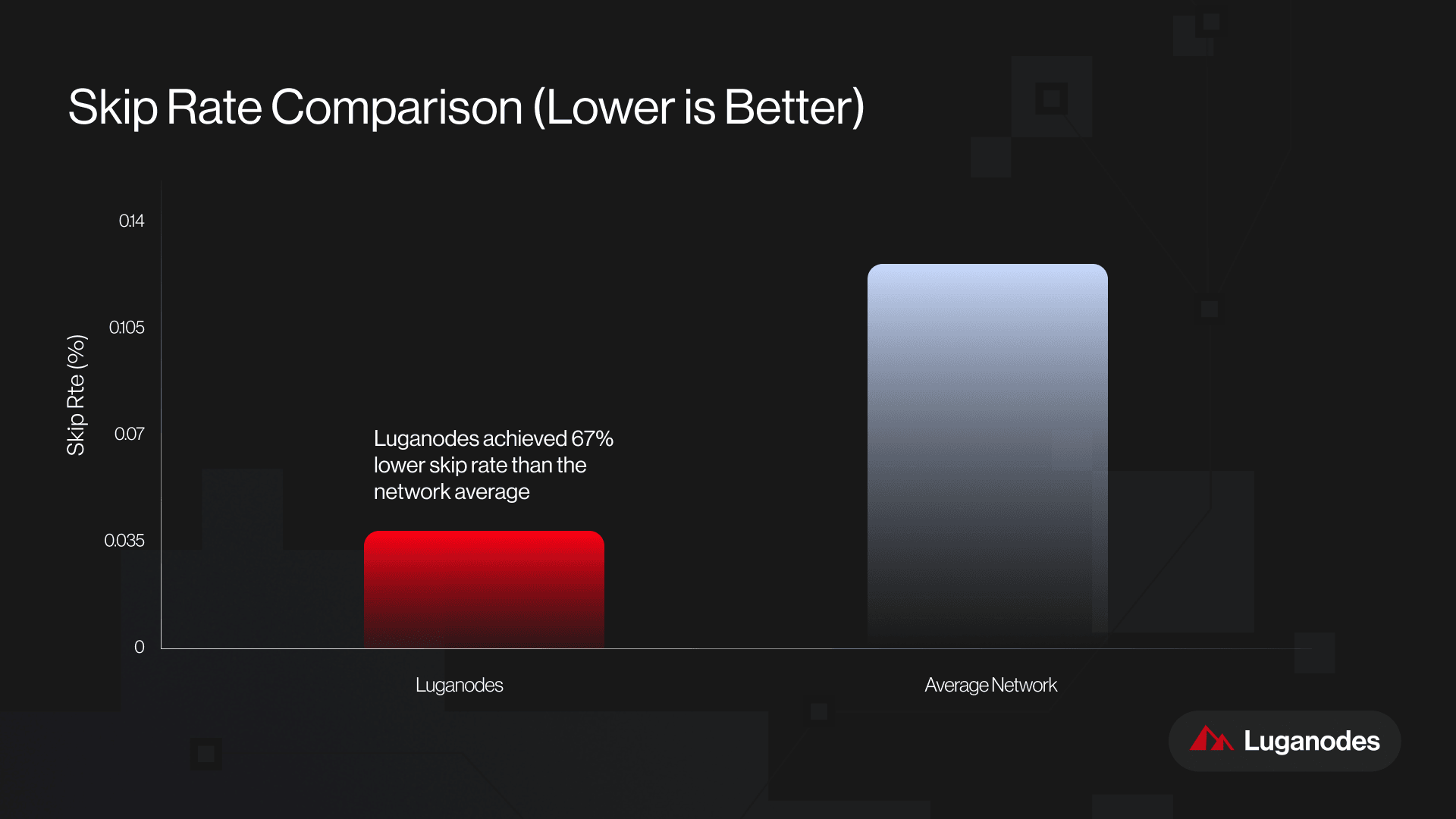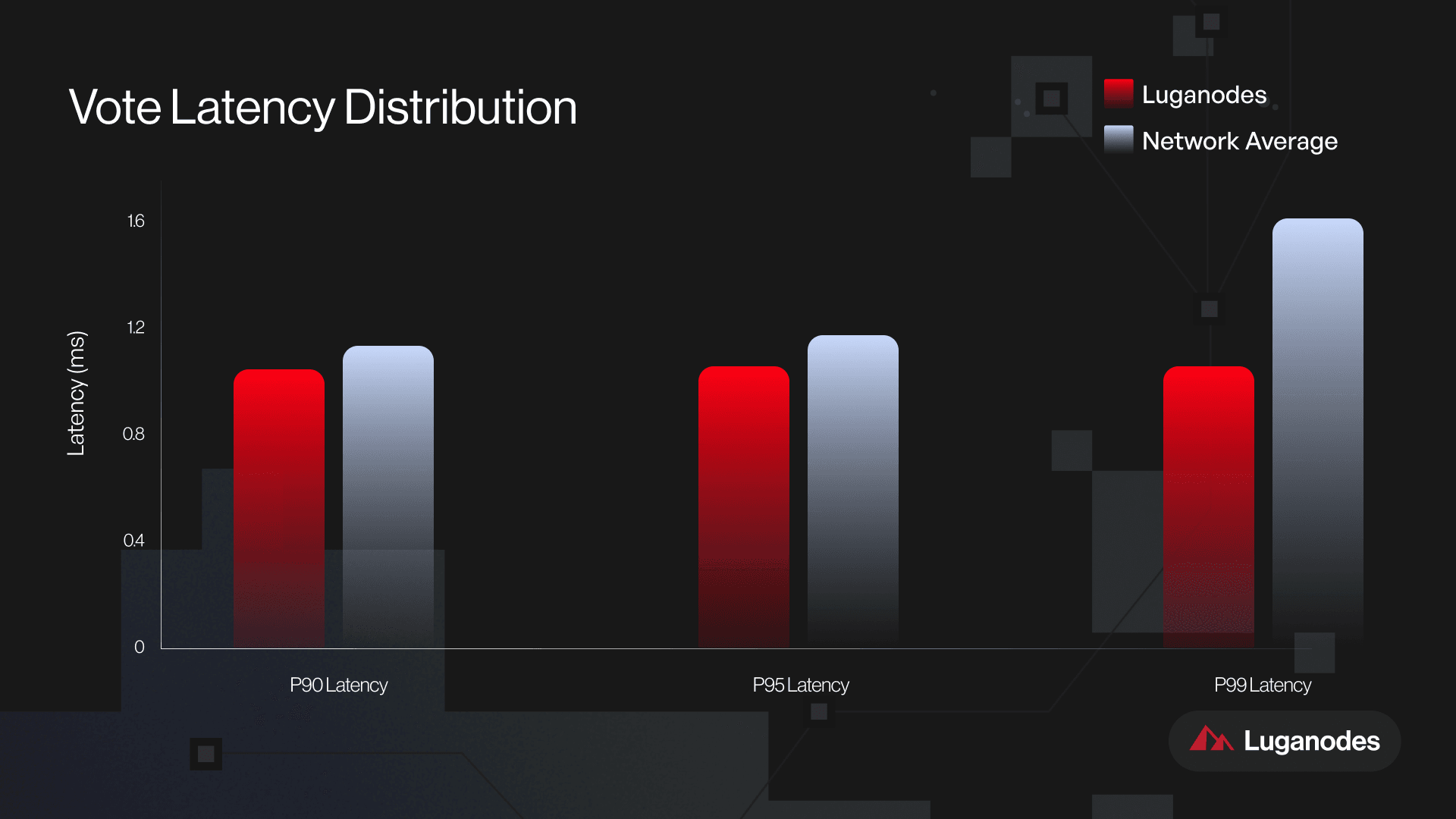9 min read
DoubleZero: Blockchain Infrastructure from the Ground Up
Innovations on the Physical Layer

Introduction
Luganodes recently began leveraging DoubleZero for its Solana validator operations. Since then, alongside other validators who have embraced DoubleZero, nearly 14% of Solana’s network stake now runs through its infrastructure. This is a remarkable development for a project still in its testnet phase, gearing up for a mainnet launch later this year.
In this report, we take a closer look at DoubleZero’s origins, architecture, ecosystem adoption, and roadmap, while also presenting our own performance data as a validator operating on DoubleZero. The analysis offers a granular view of DoubleZero’s impact on validator operations and contextualizes it within the broader Solana epoch averages.
Mission and Vision: N1 Infrastructure for Blockchain
DoubleZero defines itself as an N1 (Network 1) protocol—a neutral, foundational base layer of physical infrastructure. Unlike traditional Layer 1 or Layer 2 blockchain protocols, which address consensus or computation, N1 focuses on the underlying network fabric itself.
The project emerged from a recognition that the public internet is fundamentally mismatched with the demands of high-performance blockchains. While the internet excels at general-purpose connectivity, it introduces unpredictable packet routing, latency spikes (jitter), bandwidth constraints, and spam traffic burdens on validators. These inefficiencies collectively limit throughput and reliability, preventing blockchains from reaching their full performance ceiling.
DoubleZero’s mission is to build a dedicated physical layer optimized for blockchain and distributed systems, addressing these bottlenecks head-on.
Core Technical Architecture: Dual-Ring, FPGAs, and Decentralized Fiber
At its core, DoubleZero is a permissionless, high-performance network that leverages underutilized global fiber—such as dark fiber and surplus enterprise capacity—contributed by independent participants. By tapping into existing infrastructure instead of laying new cables, DoubleZero avoids massive capital expenditures while achieving rapid scalability.
The network is structured as a dual-ring system:
-
Outer Ring (Ingress/Egress): Interfaces with the public internet, filtering spam, removing duplicates, verifying signatures, and mitigating DDoS attacks. These tasks are handled by high-performance hardware, reducing computational strain on validators.
-
Inner Ring (Data Flow): Processes clean, verified traffic over optimized high-bandwidth connections. This ensures consistent state propagation and minimizes the routing inefficiencies of the public internet.
Supporting this design are custom switches equipped with Field-Programmable Gate Arrays (FPGAs). These enable line-speed cryptographic verification and deduplication at gigabit throughput levels. Additionally, multicast traffic support allows efficient one-to-many data distribution, reducing bandwidth load while ensuring validator synchronization.
A smart contract-defined system coordinates the network. Contributors publish verifiable data (bandwidth, latency, endpoints) on-chain, enabling programmable bandwidth allocation and incentivizing participants based on their contributions.
The Bandwidth Problem: The New Scalability Bottleneck
For years, blockchain scalability debates revolved around computation—optimizing virtual machines, improving data availability, or introducing Layer 2 rollups. But with validator clients like Firedancer (developed by Jump Crypto for Solana) now demonstrating 1 million transactions per second (TPS) in controlled environments, computation is no longer the limiting factor.
Instead, as Austin Federa, DoubleZero co-founder, has emphasized, the public internet itself has become the bottleneck. Unpredictable routing, latency jitter, and spam traffic now constrain blockchain performance more than CPU cycles.
This shift signals a new industry consensus: scaling requires re-architecting the physical communication layer. DoubleZero represents a first-mover effort in this domain, positioning the network bandwidth problem as central to the next phase of blockchain infrastructure.
The implications extend well beyond blockchains. Other latency-sensitive distributed systems, such as AI inference networks, high-frequency trading, gaming, and content delivery—stand to benefit from decentralized, low-latency physical networking.
Founding Team and Early Backers
DoubleZero’s founding team brings experience from both blockchain ecosystems and telecom infrastructure:
-
Austin Federa – Co-founder, formerly Director of Strategy & Communications at Solana Foundation.
-
Andrew McConnell (CTO) - Deep experience in financial exchange infrastructure and high-performance global network engineering.
-
David McIntyre (COO) – Also ex-Solana Foundation, with expertise in technology and finance.
-
Mateo Ward – Co-founder with telecom and high-frequency trading infrastructure background.
-
Nihar Shah – Ex-Mysten Labs head of data science, now Chief Economist.
In March 2025, the DoubleZero Foundation raised $28 million in a token round led by Dragonfly and Multicoin Capital, valuing the project at $400 million. Other backers include GSR, Borderless Capital, Superscrypt, Standard Crypto, Delphi Digital, Wintermute, RockawayX, and individual figures such as Anatoly Yakovenko and Raj Gokal.
The funding is earmarked for scaling operations, hiring in marketing, developer relations, and preparing for mainnet launch.
Testnet Deployment and Geographic Footprint
As of August 2025, nearly 14% of Solana’s active stake operates on DoubleZero—an extraordinary achievement for a project still in testnet.
13.97% of mainnet Solana stake operation on DoubleZero https://t.co/LkbcjHnhd8
— Austin Federa | 🇺🇸 (@Austin_Federa) August 27, 2025
The network footprint spans seven global cities—Singapore, Tokyo, Los Angeles, New York, London, Amsterdam, and Frankfurt—strategically chosen for their concentration of Solana stake. Each site hosts DoubleZero hardware that provides private bandwidth between city pairs, cutting down latency across dispersed validator clusters.
The testnet already supports a 20 Gbps global network, with capacity upgrades planned to 100 Gbps and 400 Gbps. By mainnet launch in H2 2025, DoubleZero aims to expand to 26 cities across 16 countries, targeting over 70 global connections.
User and Operator Feedback: Reported Benefits
Feedback from early validators and partners has been consistent across several areas:
-
Improved Validator Efficiency
Validators note significant offloading of tasks like spam filtering and transaction deduplication. According to operator feedback, this separation of concerns allows them to allocate more resources to execution and consensus, improving throughput without centralizing validator operations. -
Reduced Latency and Improved Routing
One of the most cited benefits is reduced latency relative to the public internet. Direct fiber links eliminate routing inefficiencies, producing more reliable block propagation and faster finality. According to testnet partners, this has already resulted in smoother block production. -
Enhanced Decentralization
By lowering the economic and performance barriers of running validators in diverse geographies, DoubleZero has made it feasible for nodes to operate in regions previously disadvantaged by internet routing. Federa has noted that token distribution was specifically targeted at “real validators”, reinforcing decentralization incentives. -
Institutional-Grade Reliability
Performance has been tuned for financial-grade use cases, where latency sensitivity is critical. This has made DoubleZero attractive not only for blockchain operators but also for institutions exploring DePIN infrastructure. -
Decentralized Alternative to Centralized Providers
Validators emphasized that DoubleZero provides the benefits of private networking—predictability, low latency, resilience—without depending on centralized intermediaries like Cloudflare. This aligns with Web3’s ethos of decentralization.
Co-Founder of @doublezero and CTO of @MalbecLabs_xyz, Andrew McConnell on Latency and Jitter over the Public Internet vs DoubleZero pic.twitter.com/bYc2vNCeDP
— DoubleZero (@doublezero) March 7, 2025
As Federa frequently summarizes: “The public internet wasn’t built for blockchain networks. DoubleZero is engineered to close that gap.”
Quantitative Performance Benchmarks
DoubleZero’s stated goal is to be “meaningfully more performant than the public internet”. Its impact is measured through latency, throughput, and jitter.
Latency
A RIPE Atlas probe between Amsterdam (AMS) and Frankfurt (FRA) on the DoubleZero testnet recorded sub-10ms latency—a stark contrast to the variability and jitter typically observed on public internet paths (often exceeding 15–20ms with irregular spikes).
The controlled environment at Breakpoint 2024 further highlighted latency benefits when the Solana Firedancer client ran on DoubleZero, achieving 1 million TPS—a record demonstration showing that communication bottlenecks, not computation, are the gating factor for scaling.
Throughput
Today, the DoubleZero testnet runs on a 20 Gbps backbone. This has already supported meaningful validator traffic. Roadmap upgrades to 100 Gbps and 400 Gbps will expand throughput exponentially, paving the way for validator clusters and bandwidth-heavy applications.
Jitter
Operator-reported benchmarks show stable latency percentiles with negligible jitter, a critical factor for consensus reliability. Unlike the internet’s unpredictable spikes, DoubleZero’s dedicated fiber ensures deterministic performance.
Luganodes Performance Highlights
Luganodes has been a mainstay, consistently ranking among the top-performing validators on Solana. With the adoption of DoubleZero’s high-speed testnet lanes, our institutional-grade operations have gained an additional layer of reliability and responsiveness. The data below illustrates how DoubleZero empowers Luganodes to outperform network averages across key metrics, providing a clear, granular view of its impact compared to the broader Epoch Average for Solana validators.
Superior Reliability in Block Production
-
Skipped Blocks: Only 6 skipped out of 14,192 total, compared to an average of 23.6 skipped blocks.
-
Skip Rate: 0.042% vs 0.128% average (≈67% better).
→ Demonstrates greater consistency and uptime in block production.

Excellence in Voting Performance
-
Vote Latency: 1.008ms vs 1.030ms average (2.2% faster).
-
Low-Latency Votes: 99.21% vs 98.05% average.
-
Missed Votes: Just 394 missed out of 4.37M, versus an average of nearly 20,000 missed.
→ Highlights superior responsiveness and reliability in consensus participation.
Competitive Delegator Value
-
Commission: 10% vs 28.5% average (65% lower).
-
This translates into higher net rewards for delegators, despite Luganodes operating with a comparatively smaller active stake.
Consistency at Scale
- All latency percentiles (P90, P95, P99): Locked at 1ms, significantly tighter than average.

-
Vote Success Rate (lat2): 99.97% vs 99.3% average.
-
Compute unit usage and transaction metrics align with, or slightly outperform, network averages—showing efficiency at scale.
DoubleZero helps maintain Luganodes’ position as a highly reliable, cost-effective validator for institutional delegators; delivering speed, stability, and value well above network averages.
Roadmap and Long-Term Vision
DoubleZero’s public mainnet launch is slated for H2 2025, expanding to 26 cities in 16 countries with 70+ global connections. The roadmap is clear: progressively scale bandwidth, geographic reach, and validator participation.
In the long term, DoubleZero aims to serve as a general-purpose, high-performance networking layer for distributed systems beyond blockchains. Use cases include AI model inference, high-frequency trading, gaming, and CDN delivery.
As Federa has stated, the vision is to build infrastructure where decentralized systems can rival centralized ones in performance—without compromising permissionless validation or decentralization.
Conclusion
DoubleZero represents a pivotal shift in blockchain infrastructure, tackling the bandwidth problem that has emerged as the core scalability bottleneck. By leveraging underutilized fiber, integrating FPGA acceleration, and aligning incentives through smart contracts, DoubleZero is not merely patching internet inefficiencies—it is re-architecting the physical communication layer of Web3.
For Luganodes, the adoption of DoubleZero has already delivered quantifiable improvements in reliability, latency, and cost efficiency. As DoubleZero moves toward mainnet, its trajectory suggests it will become a cornerstone of decentralized infrastructure, powering the next generation of high-performance distributed systems.
About Luganodes
Luganodes is a world-class, Swiss-operated, non-custodial blockchain infrastructure provider that has rapidly gained recognition in the industry for offering institutional-grade services. It was born out of the Lugano Plan B Program, an initiative driven by Tether and the City of Lugano. Luganodes maintains an exceptional 99.9% uptime with round-the-clock monitoring by SRE experts. With support for 45+ PoS networks, it ranks among the top validators on Polygon, Polkadot, Sui, and Tron. Luganodes prioritizes security and compliance, holding the distinction of being one of the first staking providers to adhere to all SOC 2 Type II, GDPR, and ISO 27001 standards as well as offering Chainproof insurance to institutional clients.
The information herein is for general informational purposes only and does not constitute legal, business, tax, professional, financial, or investment advice. No warranties are made regarding its accuracy, correctness, completeness, or reliability. Luganodes and its affiliates disclaim all liability for any losses or damages arising from reliance on this information. Luganodes is not obligated to update or amend any content. Use of this at your own risk. For any advice, please consult a qualified professional.